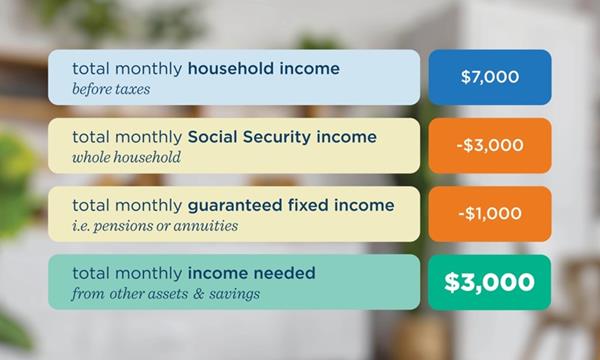Determining the amount you need in savings before retiring can be tricky — but with some simple calculations, you can better understand the finances needed for a comfortable retirement.
According to a recent AARP Financial Security Trends Survey, 61% of people ages 50+ are worried they won’t have enough money for retirement. Of those surveyed, 20% said they have no money at all saved for their retirement years.
The age-old question (no pun intended) of how much money is needed to retire comfortably is one that doesn’t have a simple, “one-size-fits-all” answer.
Sometimes, this question doesn’t even cross your mind until you’re very close to your retirement years.
Many people assume that Social Security income plus an IRA or 401(k) funded at 3% of their annual income will allow for a comfortable retirement. Unfortunately, because of inflation, cost of living increases, and taxes, this is usually not the case.
Also, as a side note: many people think their expenses will be lower after they retire. But, when you think about it… if you’re home all day, you will probably want to pursue hobbies, activities, or travel opportunities you didn’t have time for while working. If you want to remain active in retirement, your expenses may increase, so consider this when determining your current income or income needed in retirement.
In a best-case scenario, you would work with a financial advisor who can guide your retirement planning and savings, so you don’t have any surprises after you retire.
But even if you don’t have a financial advisor to help you, there are some easy methods to help you identify whether you have enough saved to sustain a long, comfortable retirement phase.
Estimating Your Financial Needs for Retirement
This scenario assumes you have consistently paid your bills on time — without regular financial stress — and is calculated with the income you will have (or had) during your last year of full-time employment.
It’s a very simplified approach, but it’s a good starting point for determining your savings goal. (Also, as a note, this scenario assumes that you are happy with the standard of living during your final year of working full-time.)
To get started, take the total household income (monthly) before taxes during your final year of work and deduct the amount you will receive for Social Security benefits (the total for both spouses, if you are married) and any other guaranteed fixed income such as pensions or annuities.

In this example, $3,000 per month is the remainder; this is the shortfall in income that you would need to provide via other assets or savings.
To determine the amount of savings it would take to produce a guaranteed $3,000 per month for the rest of your life, multiply the monthly shortfall by 12 months to calculate the annual income needed.
$3,000/month x 12 months = $36,000/year
Next, divide the annual income by 0.045 (this is the percentage guaranteed lifetime annuities use to calculate the present value of cash needed). In this case…
$36,000 / 0.045 = $800,000
So, in this scenario, you would need $800,000 in savings to produce $36,000 of annual income for all the retirement years of your household (until the last spouse passes away).
For many Americans, $800,000 sounds like a very high number. So, if you’re thinking this is unattainable, you’re not alone.
When using this formula, most people won’t meet the minimum amount needed in their savings account for retirement.
Of course, this is just a starting point. For a more accurate analysis of your financial needs, we recommend consulting with a professional financial advisor.
The Good News: Reverse Mortgages Could Help
Most Americans have been depositing money into their homes for many years and don’t realize they have enough home equity to give them a comfortable retirement.
The question becomes: how do you withdraw from this equity account without having to incur a monthly payment or a larger monthly payment? Remember, during the working years (financial professionals call this the “accumulation phase”), you are building cash and assets to draw on when you retire (known as the “distribution phase”).
You can think of reverse mortgages in the same way. A traditional mortgage is your “accumulation phase” and a reverse mortgage may be the answer for your “distribution phase.”
A reverse mortgage will allow you to access the savings inside your home without requiring you to make a monthly principal or interest payment. In some cases, it can be a helpful way for seniors to increase their monthly cashflow, pay off or consolidate other debts, and increase their savings for retirement.
Interested in learning more? Get in touch with a trusted Reverse Mortgage Specialist at Waterstone Mortgage to see if you might qualify for a reverse mortgage. It’s our goal to help senior citizens create a more financially stable and secure retirement.
These materials are not from HUD or FHA and were not approved by HUD or a government agency.
The only reverse mortgage insured by the U.S. Federal Government is called a Home Equity Conversion Mortgage (HECM), and is only available through a Federal Housing Administration (FHA)-approved lender. Not all reverse mortgages are FHA insured. When the loan is due and payable, some or all of the equity in the property that is the subject of the reverse mortgage no longer belongs to borrowers, who may need to sell the home or otherwise repay the loan with interest from other proceeds. A lender may charge an origination fee, mortgage insurance premium, closing costs and servicing fees (added to the balance of the loan). The balance of the loan grows over time and you are charged interest on the balance. Borrowers are responsible for paying property taxes, homeowner’s insurance, maintenance, and related taxes (which may be substantial). There is no escrow account for disbursements of these payments. A set-aside account can be set up to pay taxes and insurance and may be required in some cases. Borrowers must occupy home as their primary residence and pay for ongoing maintenance; otherwise the loan becomes due and payable. The loan also becomes due and payable (and the property may be subject to a tax lien, other encumbrance, or foreclosure) when the last borrower, or eligible non-borrowing surviving spouse, dies, sells the home, permanently moves out, defaults on taxes, insurance payments, or maintenance, or does not otherwise comply with the loan terms. Interest is not tax-deductible until the loan is partially or fully repaid.





